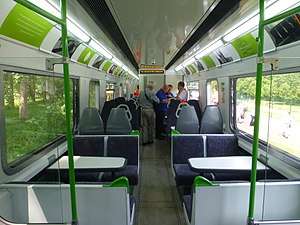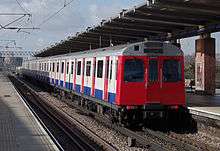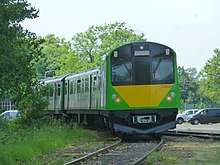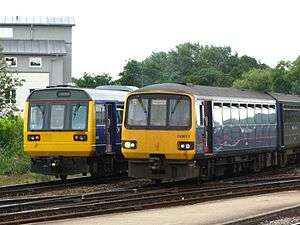British Rail Class 230
| British Rail Class 230 "D-Train" | |
|---|---|
 230 001 approaching Honeybourne in June 2017 | |
 Interior of 230 001 | |
| Manufacturer |
Metro Cammell Vivarail (conversion) |
| Constructed |
1979–1983 Converted: 2015– |
| Number under construction | 8 units to be converted |
| Number built |
2 prototype units 1 conventional unit |
| Formation | 2 or 3 cars per trainset |
| Fleet numbers | 230001–230005 |
| Operator(s) |
West Midlands Trains (planned) Transport for Wales (planned) |
| Specifications | |
| Car body construction | Aluminium |
| Car length |
Driving Motor: 18.37 m (60 ft 3 in) Other: 18.12 m (59 ft 5 in) |
| Width | 2.85 m (9 ft 4 in) |
| Maximum speed | 60 mph (97 km/h) |
| Prime mover(s) | Ford Duratorq |
| Engine type | Diesel 3.2-litre (200 cu in) |
| Cylinder count | 5 |
| Cylinder size | ? |
| Traction motors | AC by Traktionssysteme Austria GmbH. |
| Power output | 400 hp (300 kW) per car |
| Safety system(s) | AWS, TPWS |
| Coupling system | Wedgelock coupling |
The British Rail Class 230 or D-train is a diesel electric multiple unit or battery EMU built by rolling stock manufacturer Vivarail for the British rail network. The units are converted from London Underground D78 Stock, originally manufactured during 1980 by Metro Cammell. The conversion re-uses the D78's aluminium bodyshells with refurbished interiors, the traction motors and bogies, and replaces the four-rail traction-current system with a diesel-generator or battery-packs.
The type has been assigned the designation of Class 230 under TOPS.[1]
During August 2016, a prototype was produced for testing and accreditation; the type was planned to be prepared to enter passenger service during the following year.[2] During July 2016, it was announced that the prototype was to be tested in mainline service on the Coventry to Nuneaton Line over a 12-month period with operator London Midland;[3] however, this trial deployment had to be postponed after the prototype was damaged by a fire and could not be repaired quickly enough.[4] It is proposed to run 75 units of two or three cars per unit.[5][6] During October 2017, West Midlands Trains announced that it would procure three 2-car D-Trains for the Marston Vale line.[7]
History

During November 2014, Vivarail purchased 150 driving motor cars and 300 carriages of London Underground D78 Stock, which has been replaced by S Stock before the end of their lifespan, so that the subsurface lines (Circle, District, Hammersmith & City and Metropolitan) could have a common rolling stock fleet compatible with a new ATO system. The stated purpose of the D-train is to ameliorate a perceived shortage of affordable, modern rolling stock on Britain's regional rail routes, resulting from the slow pace of electrification.[8] In the conversion programme, the company re-uses the aluminium bodyshells, traction motors and bogies from the D78 units, and fit them out with new diesel engines and interiors.[9][10]
Two prototype units are being operated by Vivarail, designated as 230001 and 230002.[11] The diesel-electric multiple unit (DEMU) 230001 variant is a three-car unit; each of these is outfitted with passenger fitting and fixtures, including seats, tables, a single toilet, onboard Wi-Fi, and electrical charging points. 230001 retains the original Brush DC traction motors, however future units will make use of TSA AC motors.
The 230002 variant, which was completed during 2018, is a battery electric multiple unit, designed for operating on partially-electrified routes.[11] It features four 106 kWh battery rafts, which shall provide for an operational range of 64 km, requiring an eight-minute charge after each journey. The battery-powered train can be charged through an automatic charging point. Alternative means of charging the two-car vehicle include the use of a static battery bank to provide an electric supply of either 11 kV or 33 kV. Reportedly, the train requires a minimum of 750 V to operate.[11]
The first D78 units were delivered to Vivarail on 19 January 2015; conversion of a single car prototype to facilitate testing and marketing activities commenced shortly thereafter.[12] By Summer 2016, this prototype have been completed and was running live tests upon Vivarail's own 2.5-mile (4.0 km) test track.[13][14] During November 2016, main line testing of the units began, the prototype unit being based at the Tyseley Locomotive Works while it was operating to and from Leamington Spa railway station.[15] In December 2016 one of the units caught fire during testing, leading to the indefinite postponement of further trials.[16] During March 2017, it was announced that testing of the battery-powered demonstrator had commenced at the Quinton Rail Technology Centre.[17] In February 2018, Vivarail announced that its first two-car battery unit was approaching completion and was projected to run on the mail line network during this summer.[18]
Design
The Class 230 D-Train is a family of trains, functioning either as a diesel electric multiple unit or a battery EMU dependent upon the configuration used, developed and produced by Vivarail for use upon the National Rail network.[11] According to the manufacturers, it is to be available in different layouts with various amenities, which are to be configured in order to conform with the specific requirements of a given operator to better adapt the vehicle for its operating environment. In general, the D-Train is to be fitted with accessibility toilets, refreshment trolleys, at-seat tables, Wi-Fi, smart storage solutions and iPad holders.[11] Rail Magazine reports that each power car is furnished with two underfloor engine-generator sets; Vivarail has claimed that the fuel consumption is roughly 0.5 litre per car per mile; this is about half the fuel consumption of a Pacer. The maximum speed is 60 mph (97 km/h).[9]
When adapted to its City configuration, a single D-Train would operate as either two- and three-cars per unit.[11] The two-car vehicle is to be configured to accommodate 86 seats per unit and, including standing room, provides for a total passenger capacity of 188. The three-car vehicle, when fitted with 140 longitudinal seats, shall have a total passenger capacity of 294, including those standing.[11] For the Country layout, each D-train unit is to be a three-car formation, which would accommodate 163 seats along with a total capacity of 291. In its Commuter variant, the D-Train features either two and three cars per unit.[11] The two-car vehicle accommodates 114 mixed-type seats for a total carrying capacity of 188 passengers. The three-car vehicle, furnished with 172 longitudinal seats, accommodated up to 297 passengers, while the three-car vehicle with 154 transverse seats will carry 147 standing passengers additionally.[11]
The construction practices for producing the D-Train have been promoted as being carbon-neutral as a result of deliberate efforts to reduce the levels of waste, energy consumption, time and costs involved.[11] Much of the savings has been attributed to the reuse of many high-quality elements of the original D-stock rolling stock. Emission-reduction measures have been taken, including the adoption of a diesel engine that incorporates a stop-start system, while the use of trackside maintenance practices has been promoted as contributing to meaningful empty mileage fuel savings as well as lessening its impact upon the environment.[11] The manufacturer promotes the type as being more economical to purchase, operate and maintain, and as well as for its ease of serviceability during a short duration. The D-Train has been anticipated to offer a service life in excess of 25 years.[11]
The trains themselves are former D78 Stock units, originally manufactured by Metro-Cammell of Birmingham. 150 driving motor cars and 150 intermediate trailer cars were purchased at scrap value. The bogies were supplied by Canadian rolling stock manufacturer Bombardier while the D78 Stock was in service with London Underground.[11] The 3.2 litre, five-cylinder diesel engines are manufactured by Ford in South Africa.[9] Lithium Werks (formerly Valance) are suppliers for the battery rafts, while the electronic power control systems are produced by Strukton Rail. The AC traction motors are sourced from specialist Traktionssysteme Austria. Reportedly, the design of the D-Train is compliant with current rail industry emission standards, including the applicable elements of its automotive technology.[11]
Marketing
Overview
Vivarail stated that they planned to pitch the converted trains to a number of train operating companies (TOCs), especially those bidding for the Northern franchise which was awarded in December 2015.[12] The company has positioned the D-Train as being a cost-effective alternative to buying brand new rolling stock, enabling TOCs to replace the "Pacer" railbuses in the North of England with upcycled Underground stock. However, Arriva won the bidding for the Northern franchise in December 2015 and their rolling stock plan involves purchasing brand new stock as well as taking on additional cascaded 4 car EMUs.[19][20]
According to BBC Look East, Vivarail were in talks with bidders for the East Anglia franchise. While the East Anglia franchise includes some very rural routes where currently only single carriage trains are used, the successful bidder opted for new stock instead.[21] However, the proposal has drawn criticism from the Rail Maritime and Transport Union as being a scheme to provide "second-hand" trains to the region instead of new stock.[22]
Potential customers
In May 2015, it was claimed Arriva Trains Wales were to open talks with Vivarail over taking on converted D78s.[23] Under a recent franchise agreement, FirstGroup (operator of the Great Western Railway franchise) has agreed to carry out a study on the use of overhauled Vivarail D-Trains on branch lines by the end of the year, possibly leading to a trial of the units.[24]
During September 2015, it was revealed that Coventry City Council were looking into the possibility of using converted D78s to run additional services on the Coventry to Nuneaton Line; this would be especially useful to serve Coventry Arena station during match days at the Ricoh Arena, as well as to alleviate a shortage of rolling stock.[25] London Midland subsequently announced in July 2016 of their intention to run a prototype 3-car set for a year-long trial on this line[26] before the prototype unit caught fire during testing which led to the trial being cancelled.[4][27]

In June 2016, a revived version of open access operator Go-Op was proposed to Office of Rail & Road. The proposed service would run from 2019 between Taunton and Nuneaton via Swindon and Oxford. Under the filed plans, Go-Op intended to use a number of Class 230s between Taunton and Swindon between December 2017 and 2019. However, they did not intend to operate these trains across the full route.[28][29]
In late 2017, Vivarail announced that it had sent a brochure detailing the potential of the Class 230 for use on the Valley Lines network in South Wales to the bidders for the new Wales & Borders franchise. These would be battery-powered variants, being capable of recharging via 25 kV OHLE, which are expected to be installed.[30] In June 2018, it was announced successful bidder KeolisAmey Wales would purchase five units for use on the Borderlands Line.[31][32]
During March 2018, it was announced that plans were being developed to take a Class 230 to the United States, in order to demonstrate how they could provide a low-cost rolling stock option for new passenger services.[33][34]
In October 2018, it was reported in the Modern Railway magazine that South Western Railway had submitted plans to the Department of Transport to replace the eighty year old Class 483 units with Class 230 units on its Island Line services. A decision is expected by the end of the year.
Cost comparison
Vivarail revealed in October 2015 how the lease and ongoing costs of the Class 230 cars compare to procuring a new DMU and against existing Class 150 carriages.[35]
| Comparison | New DMU | Class 150 | Class 230 |
|---|---|---|---|
| Lease rental per car per month (£) | 15,000 | 7,500 | 7,000 |
| Non-capital lease rental per car per month (£) | 6,000 | 3,000 | 0 |
| Depot maintenance per car per mile (p) | 60 | 70 | 40 |
| Fuel consumption per car per mile (litres) | 0.8 | 0.75 | 0.5 |
Operators
West Midlands Trains
From December 2018, West Midlands Trains will operate three Class 230 units on the Marston Vale Line.[36]
Transport for Wales
The Wales & Borders franchise (operated as Transport for Wales by KeolisAmey) will operate five units on the Borderlands Line, Conwy Valley line and Chester to Crewe line from mid-2019.[31]
Incidents
On 30 December 2016, the prototype set caught fire at Kenilworth. The planned trial that Vivarail originally had arranged was postponed, and 10 people were evacuated safely.[37] It was announced in January 2017 that the planned trial on the Coventry to Nuneaton line had been cancelled.[38] An incident report, produced by Vivarail, identified a fuel leak in one of the two new engine sets as the most likely cause of the fire.[39]
In service
The first Class 230 service to carry passengers operated on 21 and 22 June 2017 when the prototype (230001) was used to operate a shuttle service from Honeybourne to the Rail Live exhibition at the Quinton Rail Technology Centre.[40][41]
During October 2017, West Midlands Trains, the new franchise holder for the West Midlands franchise, announced plans to procure three 2-car D-Train units for use on the Marston Vale line from December 2018.[7][42]
Fleet details
As of March 2017, two demonstrator units have been constructed. In October 2017, it was announced that West Midlands Trains had placed an order for three units. Initially intended to have a separate number sequence from the prototypes,[43] the production units were eventually numbered sequentially as 230/0.
| Class | Operator | Number | Cars | Year Built | Unit nos. | Type |
|---|---|---|---|---|---|---|
| Class 230/0 | Vivarail | 1 | 3 | 2016–18 | 230001 | DMU |
| 1 | 2 | 230002 | BEMU | |||
| West Midlands Trains[44] | 3 | 2 | 230003–005 | DMU | ||
| Transport for Wales[45][46] | 5 | 3 | TBC | Diesel-Battery hybrid | ||
See also
Three classes of EMUs built for use on the Isle of Wight Island Line have been constructed from former London Underground stock:
External links
References
- ↑ McCaffrey, Sam (1 May 2015). "'They don't make trains like this anymore'". Rail Technology Magazine. Retrieved 17 May 2015.
- ↑ Wade, Andrew (21 August 2015). "D-Railed: Old tube trains gain a new lease of life". The Engineer. Retrieved 18 April 2016.
- ↑ UK, DVV Media. "D-Train to enter service on Coventry - Nuneaton line". Retrieved 23 July 2016.
- 1 2 Stephen, Paul. "Vivarail D-Train trial cancelled after fire." Rail Magazine, 11 November 2016.
- ↑ "D78 Stock Conversion is Go." Modern Railways, December 2014. pp. 37-38.
- ↑ "Vivarail Homepage". Vivarail. Retrieved 20 January 2015.
- 1 2 Gibbs, Nigel (November 2017). "Vivarail 230s for new West Mids franchise as 170s to go". Today's Railways (191): 8.
- ↑ Gurdon, Martin (16 January 2015). "Back on the rails". The Engineer. Centaur Media.
- 1 2 3 Johnson, James (2 September 2015). "Vivarail begins testing on first converted D-stock". Rail Magazine. No. 782. Peterborough, England: Bauer Media. pp. 6–7.
- ↑ "New Trains For Old: From Upminster to Upcycled – Vivarail’s D-Train." Railway Magazine, 15 February 2018.
- 1 2 3 4 5 6 7 8 9 10 11 12 13 14 "Class 230 D-Train." railway-technology, Retrieved: 13 May 2018.
- 1 2 Browne, Stefanie (15 January 2015). "Vivarail ready to start converting first LU D-Stock". railmagazine.com. Bauer Consumer Media. Retrieved 24 January 2015.
- ↑ Barrow, Keith. "Prototype Vivarail D-Train on test." International Rail Journal, 25 August 2015.
- ↑ "D-Train crash test." Railway Gazette, 12 May 2015.
- ↑ "Vivarail Class 230 to start mainline testing". Rail Technology Magazine. Retrieved 13 December 2016.
- ↑ "Vivarail test train catches fire over festive period as NUCKLE trial postponed". Rail Technology Magazine. Retrieved 11 August 2018.
- ↑ "Business as usual: Vivarail begins testing of new battery train." railtechnologymagazine.com, 21 March 2017.
- ↑ "Vivarail targets summer running for new battery unit." railtechnologymagazine.com, 21 February 2018.
- ↑ "Northern franchise improvements". Department for Transport. Retrieved 18 April 2016.
- ↑ Barrow, Keith (11 December 2015). "Arriva confirms Northern rolling stock plans". International Railway Journal. Retrieved 18 April 2016.
- ↑ "Shortlist for East Anglia franchise announced". Gov.uk. 2 June 2015. Retrieved 18 April 2016.
- ↑ "Plan for old London trains in North attacked by union". BBC News. 19 February 2015. Retrieved 27 February 2015.
- ↑ Clark, Rhodri (25 May 2015). "From Piccadilly Circus to Pontypridd: Could London Underground carriages soon be used on the Welsh railway network?". Wales Online. Retrieved 18 April 2016.
- ↑ Abbott, James. "Swindon first- Other GW progress anyone's bet". Modern Railways. p. 55.
- ↑ "London Underground tube trains could be used to sort Ricoh Arena station fiasco". Coventry Telegraph. 8 September 2015. Retrieved 13 September 2015.
- ↑ "Recycled Tube trains to re-enter passenger service this year". Global Rail News. Retrieved 22 July 2016.
- ↑ "D-Train project derailed as partners pull out of trial." railtechnologymagazine.com, 10 January 2017.
- ↑ "Go-Op! Website". go-op.coop.
- ↑ "Go-Op! Presents Somerset Rail Improvement Plan". go-op.coop.
- ↑ "Vivarail D-Trains for Wales & Borders?". Today's Railways (192): 18. December 2017.
- 1 2 Annexes Government of Wales
- ↑ "Wales & Borders Overview of W&B and the South Wales Metro" (PDF). KeolisAmey Cymru. KeolisAmey Cymru. Retrieved 5 June 2018.
- ↑ "Vivarail D-Train to be tested in US cities". International Railway Journal. 9 March 2018. Retrieved 15 March 2018.
- ↑ "D-Train to target US transit market." Railway Gazette, 20 March 2018.
- ↑ "Class 230 Confounds Cynics" (PDF). RRDC. October 2015. Retrieved 28 July 2018.
- ↑ Gibbs, Nigel (November 2017). "Vivarail 230s for new West Mids franchise as 170s to go". Today's Railways (191): 8.
- ↑ "Ten evacuated as Kenilworth train catches fire". BBC News. 30 December 2016. Retrieved 30 December 2016.
- ↑ "Coventry to Nuneaton trial scrapped after test train fire". BBC News. 9 January 2017. Retrieved 10 January 2017.
- ↑ "Class 230 Full Fire Report" (PDF). Vivarail. 31 January 2017. Retrieved 10 May 2017.
- ↑ Foster, Stefanie (13 April 2017). "D-Train to carry passengers to Rail Live". Rail Magazine (824). Archived from the original on 6 July 2017. Retrieved 6 July 2017.
- ↑ Clinnick, Richard (30 June 2017). "GALLERY: D-Train interiors". www.railmagazine.com. Archived from the original on 6 July 2017. Retrieved 6 July 2017.
- ↑ http://www.railtechnologymagazine.com/Rolling-stock/vivarail-unveils-new-class-230-livery-as-west-midlands-trains-deal-signed
- ↑ "West Midlands Trains" (PDF). Stourbridge Line User Group. Retrieved 17 October 2017.
- ↑ "Vivarail to supply three D-Trains to West Midlands Trains". www.railtechnologymagazine.com. Retrieved 2018-06-05.
- ↑ "KeolisAmey reveal new-look Wales trains and services". 4 June 2018. Retrieved 8 June 2018.
- ↑ "Vivarail to supply Class 230 D-Trains to KeolisAmey".
